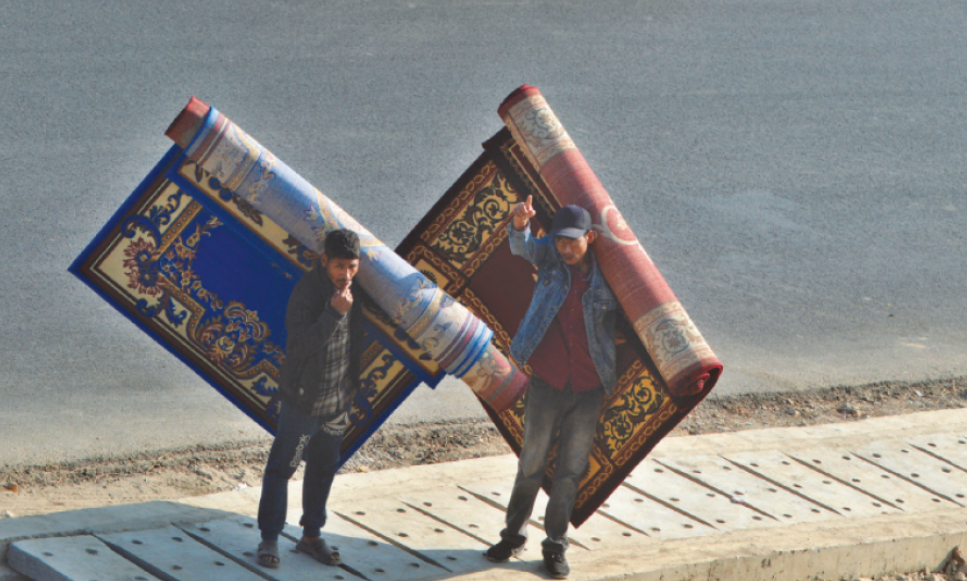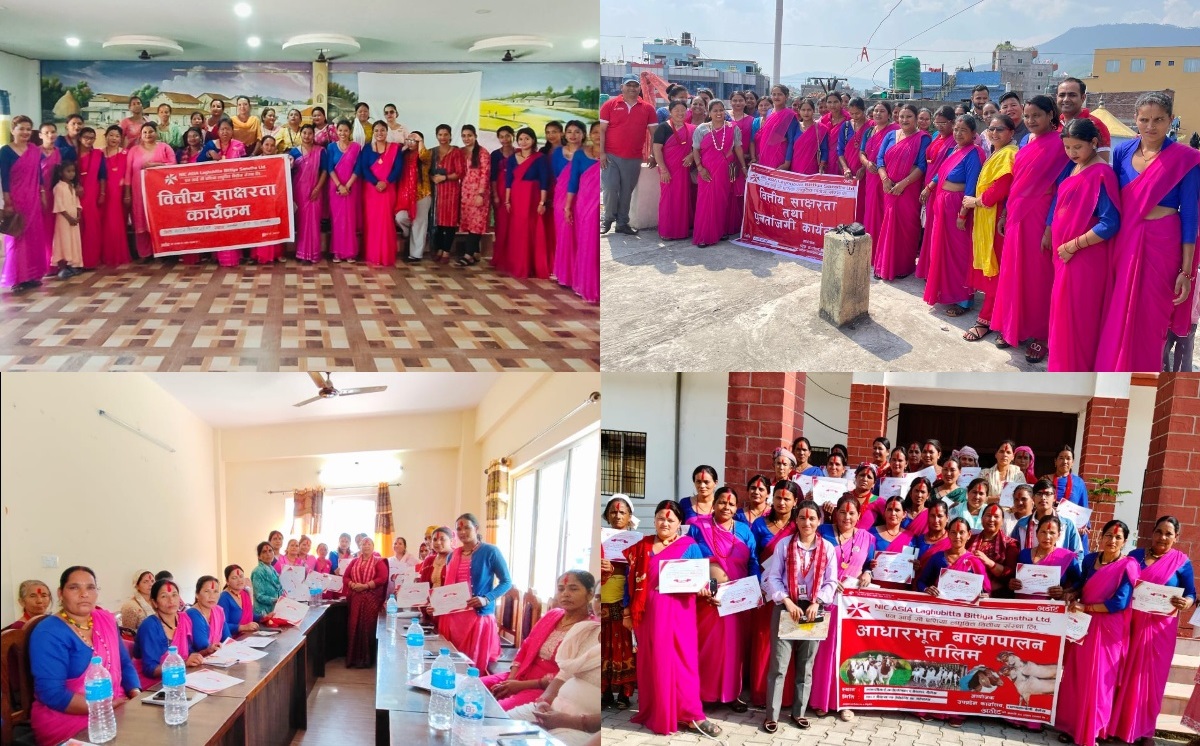Carpet business booms again, but with imported products

KATHMANDU: APRIL. 16 – Man Bahadur Malla of Kalikot in far-western Nepal has spent three decades in Kathmandu hawking carpets door to door. During those three decades, he has seen the rug industry go on a rollercoaster ride.
The 52-year-old Malla now owns a carpet store in Basantapur, but he still pounds the streets of the capital with carpets slung over his shoulder, shouting at the top of his lungs, “Aayo…Galaicha”—or “here comes the carpet.”
The big difference between the old days and today is that he now sells imported carpets while previously he used to sell locally-woven products.
In the 1990s, Nepal’s carpet industry boomed and it became a major source of foreign currency.
According to an International Labour Organisation report, Nepal’s carpet industry provided 250,000 to 300,000 jobs during its “Gold Rush” period in the early 1990s.
Nepali weavers were churning out $190 million worth of carpets annually, and carpet shipments accounted for 65 percent of the country’s total exports.
The bubble burst when reports emerged that the carpet factories were exploiting child workers.
The gold rush period opened up new opportunities for the poorest of the poor on a massive scale, according to reports. The carpet industry was one of the most prominent sectors with a remittance economy that benefited rural communities, alluring large numbers of people like Malla from remote districts to Kathmandu.
Nepal’s carpet sector experienced its first export boom in 1976, according to the International Labour Organisation.
In 1976, carpets accounted for about 7.6 percent of Nepal’s exports, and for the first time, Nepal was listed as a carpet exporting country in the Yearbook of International Trade Statistics.
The carpet sector continued increasing production. During the 1990s, demand fell behind supply, prompting unhealthy competition which led manufacturers to compromise the quality of their products.
According to the report, as all producers and exporters were competing to export their products to the same European market in general and Germany in particular, by the mid-1990s, the market for Tibeto-Nepali hand-knotted carpets had become saturated.
In the fiscal year 2001-02, the situation became worse. That year, the amount of foreign currency earned by the carpet sector showed a drop of 30 percentage points, from $117.86 million to $81.60 million.
Among the reasons for this steep decline were a worldwide economic recession and the decline in the purchasing power of consumers in the developed countries, and the inability of Nepali products to compete with Indian and Chinese carpets.
Political instability in Nepal detracted new investments and threatened the operation of the existing factories.
Malla, from remote Kalikot in the Karnali region, opened a shop at Dhungedhara in Basantapur. That was 20 years ago when carpet exports had started to fall sharply. And then the country started to import cheaper carpets.
“I bring most of my carpets from Biratnagar. The carpets we sell are machine-made, not hand-made. They come to Biratnagar via India,” said Malla. He has hired 20 men to hawk his carpets door to door.
Three decades ago in Kathmandu, Chinese vendors selling watches and wandering carpet sellers were a familiar sight on the streets. The Chinese vendors have gone, but the number of carpet sellers has risen severalfold.
The Post met Malla at Narephant in Koteshwar on Tuesday morning. He was accompanied by his brother-in-law Dinesh Rawat.
Nepali carpets are expensive, he said, so Nepali households prefer the imported variety, which is obviously of low quality.
According to Malla, there are around 300 vendors who go door to door selling carpets at different places across Kathmandu Valley. There are around five other carpet shops near Malla’s store.
Department of Customs statistics show that carpet imports have been growing. Most of the carpets sold in Nepal are imported from Belgium, India, China, the United Arab Emirates, Turkey and Egypt.
In fiscal 2013-14, Nepal imported carpets worth Rs556.71 million. After five years, in 2017-18, imports had swelled to Rs728.67 million, subsequently reaching an all-time high of Rs956.84 million in 2018-19.
Covid-19 impacted the carpet import business which dropped to Rs673.76 million in 2019-20 and further slipped to Rs596.66 million in 2020-21.
According to customs statistics, carpet imports in the first eight months of the current fiscal year were worth Rs483.55 million, and contributed a tax revenue of Rs22.40 million.
“Obviously, carpet imports are rising as they are not made of wool. Machine-made carpets are obviously cheaper,” said Hira Bahadur Lama, vice-president of the Nepal Carpet Manufacturers and Exporters Association.
“A Nepali handmade woolen carpet costs Rs200,000 or more,” Lama said. Imported ones are available for as little as Rs2,000 apiece.
According to Lama, the export of Nepali carpets has increased this year in terms of value. “This is because most of the carpet factories in India closed down, which increased the value of Nepali carpets in the international market.”
Exports of woolen carpets reached Rs5.89 billion in the first eight months of the current fiscal year ended mid-March, up 24 percent year-on-year.
Nepali woolen carpets are exported to the United States, China, Germany, Italy, the United Kingdom, Canada, Belgium, France and Australia.
Carpets made of other materials are mostly shipped to the United Arab Emirates, Egypt, Belgium, Turkey and India.
For Malla, the carpet business depends on the season.
“Business is usually down at this time of the year. We sold only two pieces on Tuesday,” said Malla, while stopping at an eatery in Imadol, Lalitpur for lunch. Sales grow during the October-November period, Nepal’s key festival season.
“I normally earn Rs25,000 to Rs30,000 per month these days by selling carpets door to door. And combined with the earnings from the shop, I make Rs60,000 to Rs70,000 per month,” said Malla. “When business booms during the festive period, I make as much as Rs150,000 per month.”
Over the years, it has become easier to continue this profession, said Malla.
“It is easier to do this business now because there are more houses, roads and hotels,” said Malla, who used to travel to Palpa, Rupandehi, Surkhet, Kalikot, Achham, Dailekh, Bajura and Bajhang districts to sell carpets. “In the past, there would be incidents of robbery, sometimes even in broad daylight.”
Vendors say they are satisfied with their profession. “It has been a profitable business,” said Rawat, 32, who has been in the trade for the last eight years.
While Malla has been sending carpets to buyers in Palpa and Surkhet, he said he could expand further if he had more capital.
“If I could get money at a low-interest rate, I would be able to buy more carpets to sell in the market,” he said. “Nowadays, people in remote Kalikot are constructing concrete and modern buildings, there will be demand for carpets. I plan to open a store there too.”
-Kathmandu Post










